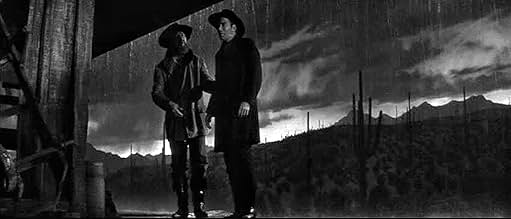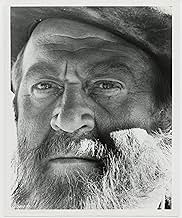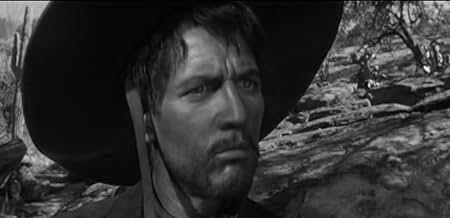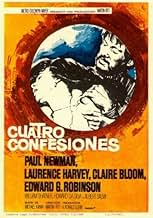IMDb RATING
6.2/10
2.6K
YOUR RATING
Travelers in the 1870s Southwest discuss a recent murder trial in which all the principals told differing stories about the events.Travelers in the 1870s Southwest discuss a recent murder trial in which all the principals told differing stories about the events.Travelers in the 1870s Southwest discuss a recent murder trial in which all the principals told differing stories about the events.
Featured reviews
Paul Newman plays a Mexican bandit so convincingly in "The Outrage" (Martin Ritt, 1964) that it's extremely difficult to recognize Newman at all. Far from being a star vehicle, the Paul Newman "persona" isn't recognizable here in the least. I must admit that for quite a while, I kept wondering when Newman was going to finally arrive on the screen, before it dawned upon me that Newman was playing the bandit. I wouldn't deem his amoral, animalistic, lusty performance brilliant because it constitutes a rather stereotypical caricature of a Mexican bandit. Nevertheless, Newman disguises himself so dramatically, to the point where "Paul Newman" is almost invisible, that his performance becomes noteworthy just the same.
Overall, Martin Ritt's Western remake of Akira Kurosawa's landmark and legendary "Rashomon" (Kurosawa, 1950) is worth viewing despite some obvious flaws. Ritt doesn't add anything new to Kurosawa's famous study in subjective truth and point-of-view prejudice, and at times, "The Outrage," which was also taken from a then-recent Broadway play, appears a bit flat and copied. Indeed, it occasionally seems as if Ritt grows bored with the story that he's copying from Kurosawa and Broadway and that he's yearning for comedy and satire in his otherwise straight remake. However, those alternative tones are never fully developed and as a result the film fails to make a dynamic impact. That same year, over in Spain, Italian director Sergio Leone remade Kurosawa's Samurai classic "Yojimbo" (1961) as a Western, but he did so with epochal results, largely because he brought a whole new visual style (a patient, rhythmic balance of stunning panorama and extreme close-ups) and directorial slant (a fluid study in operatic nihilism and surrealism) to Kurosawa's story. In other words, Leone remade a Kurosawa film and in doing so, he transformed it into something vastly different. In "The Outrage," Ritt fails to pull off the same trick.
That said, there are some aspects that recommend "The Outrage" to the viewer, and Newman's chameleon performance is just one of them. All of Ritt's remarkable directorial trademarks are on display here: his ambiguity; his objectivity; his refusal to condescend to the audience; the moral shadiness that he evokes; his rejection of black-or-white moral simplicity; his implicit and unstrained social commentary (in this case revolving around the holy trinity of race, class, and gender, not to mention regionalism); his spare, ominously striking visuality; his meditative pacing. Perhaps most noteworthy is James Wong Howe's haunting black-and-white cinematography, which reflects an ominous glow and projects an apocalyptic sensibility rather than Western grandeur. Instead of macrocosmic vistas, Howe's compositions capture a sense of claustrophobia, moral confusion, and subjective truth thanks to their low-angle and eye-level confinement. Through his camera-work, the Western landscape becomes not a romantic frontier or an open-air arena, but instead an entangling thicket where honor and honesty descend in a squalid ravine. Most remarkable are the crepuscular, stormy, forbidding shots of a forsaken railway station during a desert thunderstorm. It is here that three observers (one of which is deliciously played by the always memorable Edward G. Robinson) discuss the different versions of truth while refraining from spelling out the implications for the audience. Ritt, as usual, forces the viewer to think for him or herself. And what Ritt reveals are the human motivationspride, vanity, contempt, guilt, shame, distrust, lust, cowardice, avarice, survivalthat color the notion of truth and ultimately render it subjective. Unfortunately, as a straight remake, "The Outrage"'s presentation of these themes is a little too flat and perfunctory to leave a fresh impact. Still, the film is compelling and curious, standing as an artistic, sobering Western and the most obscure oater that Paul Newman ever starred in. And of course, Newman virtually obscures himself by becoming another.
Overall, Martin Ritt's Western remake of Akira Kurosawa's landmark and legendary "Rashomon" (Kurosawa, 1950) is worth viewing despite some obvious flaws. Ritt doesn't add anything new to Kurosawa's famous study in subjective truth and point-of-view prejudice, and at times, "The Outrage," which was also taken from a then-recent Broadway play, appears a bit flat and copied. Indeed, it occasionally seems as if Ritt grows bored with the story that he's copying from Kurosawa and Broadway and that he's yearning for comedy and satire in his otherwise straight remake. However, those alternative tones are never fully developed and as a result the film fails to make a dynamic impact. That same year, over in Spain, Italian director Sergio Leone remade Kurosawa's Samurai classic "Yojimbo" (1961) as a Western, but he did so with epochal results, largely because he brought a whole new visual style (a patient, rhythmic balance of stunning panorama and extreme close-ups) and directorial slant (a fluid study in operatic nihilism and surrealism) to Kurosawa's story. In other words, Leone remade a Kurosawa film and in doing so, he transformed it into something vastly different. In "The Outrage," Ritt fails to pull off the same trick.
That said, there are some aspects that recommend "The Outrage" to the viewer, and Newman's chameleon performance is just one of them. All of Ritt's remarkable directorial trademarks are on display here: his ambiguity; his objectivity; his refusal to condescend to the audience; the moral shadiness that he evokes; his rejection of black-or-white moral simplicity; his implicit and unstrained social commentary (in this case revolving around the holy trinity of race, class, and gender, not to mention regionalism); his spare, ominously striking visuality; his meditative pacing. Perhaps most noteworthy is James Wong Howe's haunting black-and-white cinematography, which reflects an ominous glow and projects an apocalyptic sensibility rather than Western grandeur. Instead of macrocosmic vistas, Howe's compositions capture a sense of claustrophobia, moral confusion, and subjective truth thanks to their low-angle and eye-level confinement. Through his camera-work, the Western landscape becomes not a romantic frontier or an open-air arena, but instead an entangling thicket where honor and honesty descend in a squalid ravine. Most remarkable are the crepuscular, stormy, forbidding shots of a forsaken railway station during a desert thunderstorm. It is here that three observers (one of which is deliciously played by the always memorable Edward G. Robinson) discuss the different versions of truth while refraining from spelling out the implications for the audience. Ritt, as usual, forces the viewer to think for him or herself. And what Ritt reveals are the human motivationspride, vanity, contempt, guilt, shame, distrust, lust, cowardice, avarice, survivalthat color the notion of truth and ultimately render it subjective. Unfortunately, as a straight remake, "The Outrage"'s presentation of these themes is a little too flat and perfunctory to leave a fresh impact. Still, the film is compelling and curious, standing as an artistic, sobering Western and the most obscure oater that Paul Newman ever starred in. And of course, Newman virtually obscures himself by becoming another.
Sometimes, I'm amazed at the low level of commentary on these films. This one is no exception. The reviewer opening these comments comments on a "Western" as if this were a Roy Rogers or Gene Autry oater. While I'm aware that we all have the right to express our views, I would like to see a little more insight on those selecting which reviews will be presented. This film is a remake and reset of the Kurusawa classic and is a classic in its own right. Fine, fine performances are given by Newman, Harvey, Bloom, Shatner(in his pre-Kirk days), Robinson, Salmi, Da Silva and Fix in this casting of a Japanese film play-- which is a composite of two stories, BTW-- by Akira Kurusawa. It's not perfect. The role of the medium, the old Indian shaman portrayed by veteran character actor, Paul Fix, doesn't have the cultural impact of the original. There is confusion around the rape and fight scene, but these are small things. The film is marvelous and the black and white setting captures much of the shading and light contrasts of the original Rashomon. The story in both films, which Kurusawa wove out of two earlier stories, is full of archetypes but lacking much of the impending chaos of the original. The first tale of the old gate at kyoto tells of a ronin confronting an old woman and taking the blanket from an abandoned child in the time of civil war and political upheaval; the other tale, in the woods, tells of the various versions of rape, murder, honor and shame, told by each of the participants. Kurusawa blended them into an excellent film story. While the cultural background of the original sets it apart from this American version, there is much that does make it work. The genteel Southern couple, the Mexican bandido, the pragmatic sheriff, the country preacher, the snake-oil salesman and the miner/prospector, fit the Samurai, bandit, medium, etc., of the original very well. So, face it. It ain't John Wayne. But it's good cinema at it best.
I am familiar with Kurosawa's "Rashomon", which is original work interestingly remade in Hollywood by Martin Ritt. Those who have seen both works will be able to note the obvious virtues of the original. Yet, I saw this film with no prior knowledge of the fact that this was a remake of Rashomon.
What struck me within minutes of opening of the film was the unusual camerawork of James Hong Howe, that takes pleasure in close-ups and tilted shots that are reminescent of European cinema of the sixties. It is so far removed in style from Hollywood.
Reams of paper have used to write about Akutagawa's story immortalized by Kurosawa. So I have nothing to add on the brilliant story that obviously attracted Ritt and the playwrights Kanin.
What is unusual is Ritt's treatment. His choice of actors are interesting--Claire Bloom is a fine choice as she has a range of emotions to display with credibility; Laurence Harvey's role is limited even though he occupies a long screentime gagged and bound but he has to show scorn for a brief period the gag is removed without speaking--and when he speaks his face is not visible; Edward G Robinson is a perfect choice for a snake oil salesman and so on...
Ritt's use of the soundtrack is again non-Hollywood in style. He uses music and uses silence with great effect while characters talk to underline the emotions. Kurosawa did it to the extreme limits that makes it odd for the non-Japanese viewer.
Ritt is an interesting director. I have always admired his choice of subjects to film. I prefer his black and white films to his color projects because of the subjects that he chose to film--"Edge of the City" being one of my favorite Ritt works. The second reason I admire him is for his choice of actors, especially for the major female roles. He has derived great performances as he did here with Bloom.
This film will never be talked about because it is a remake of a classic. However, in my view it stands out as unlike John Sturges' "Magnificent Seven," which was also a remake of another Kurosawa work in Hollywood, this film adopted a different style closer to Europe and Japan. It is essentially a fine work of depicting a play on film somewhat like nuggets of celluloid gold found among the works of the American Film Theatre series.
What struck me within minutes of opening of the film was the unusual camerawork of James Hong Howe, that takes pleasure in close-ups and tilted shots that are reminescent of European cinema of the sixties. It is so far removed in style from Hollywood.
Reams of paper have used to write about Akutagawa's story immortalized by Kurosawa. So I have nothing to add on the brilliant story that obviously attracted Ritt and the playwrights Kanin.
What is unusual is Ritt's treatment. His choice of actors are interesting--Claire Bloom is a fine choice as she has a range of emotions to display with credibility; Laurence Harvey's role is limited even though he occupies a long screentime gagged and bound but he has to show scorn for a brief period the gag is removed without speaking--and when he speaks his face is not visible; Edward G Robinson is a perfect choice for a snake oil salesman and so on...
Ritt's use of the soundtrack is again non-Hollywood in style. He uses music and uses silence with great effect while characters talk to underline the emotions. Kurosawa did it to the extreme limits that makes it odd for the non-Japanese viewer.
Ritt is an interesting director. I have always admired his choice of subjects to film. I prefer his black and white films to his color projects because of the subjects that he chose to film--"Edge of the City" being one of my favorite Ritt works. The second reason I admire him is for his choice of actors, especially for the major female roles. He has derived great performances as he did here with Bloom.
This film will never be talked about because it is a remake of a classic. However, in my view it stands out as unlike John Sturges' "Magnificent Seven," which was also a remake of another Kurosawa work in Hollywood, this film adopted a different style closer to Europe and Japan. It is essentially a fine work of depicting a play on film somewhat like nuggets of celluloid gold found among the works of the American Film Theatre series.
This remarkable 1964 film has many virtues, among them a strong script, fine photography, and a pre-Kirk William Shatner (whose idiosyncratic acting style is already well-developed, however).
The story is a Westernization of "Rashomon", the story of a rape and murder told from the points of view of three participants and an outsider. The contrast between the subjective stories (told by the bandit, the husband, and the wife) and the story told by the miner who witnesses what really happens is both hilarious and thought provoking.
Everyone is in fine form, but DaSilva's miner and Edward G. Robinson's snake oil salesman are especially fine. Newman's portrayal of the Mexican bandit is often over-the-top, but always interesting.
This is one of those movies that makes one wonder if Mr. Maltin saw the same thing. I think that it is one of the better films of the 60's, a decade that produced a great many of the best movies ever made.
The story is a Westernization of "Rashomon", the story of a rape and murder told from the points of view of three participants and an outsider. The contrast between the subjective stories (told by the bandit, the husband, and the wife) and the story told by the miner who witnesses what really happens is both hilarious and thought provoking.
Everyone is in fine form, but DaSilva's miner and Edward G. Robinson's snake oil salesman are especially fine. Newman's portrayal of the Mexican bandit is often over-the-top, but always interesting.
This is one of those movies that makes one wonder if Mr. Maltin saw the same thing. I think that it is one of the better films of the 60's, a decade that produced a great many of the best movies ever made.
"The Outrage" is a re-make of the Akira Kurosawa classic "Rashomon." It's a very faithful adaptation but does not improve upon the original. It would have been better served not to have been as faithful as it was. The cinematography of "Rashomon," for instance, is groundbreaking and an all-time great. Martin Ritt's remake is slicker and more modern but not better. "Outrage" is set in the old west, where the original was set in feudal Japan. Four years before "Outrage," director John Sturges remade Kurosawa's `Seven Samurai' into "The Magnificent Seven." Both are classics. Ritt's stab at Kurosawa (a slightly older film) has been swept up into the sands of film history and is little-remembered. This despite an all-star cast that includes Edward G. Robinson, Laurence Harvey, William Shatner, and Paul Newman as (agh!) a Mexican outlaw.
The source material for "Magnificent Seven" is a story and a script written for film. The source material for "Outrage" technically is a short story written in the early 20th century by Ryunosuke Akutagawa called "In A Grove," from which "Rashomon" was also adapted. Oddly, `Rashomon' is another story altogether, by the same author. The Rashomon Gate is the largest entrance to the walled, then-capital of Japan, Kyoto. Having chosen this the setting for the telling of the film's story, as the three souls take refuge from a storm under this giant gate, Kurosawa re-named the film after it. Instead of going back to the original source, Ritt remakes Kurosawa's film. In doing so, Ritt walks into a trap many filmmakers do when trying to faithfully remake a much-loved piece of work. To remake a film seems to convey that the original lacked something or was somehow flawed. "Rashomon" clearly did not need to be re-made. But once the decision was made to make another version, whether Ritt used the film or the Akutagawa story as his source, it's a no-win situation. Even if he'd based it on the original story, he would have spent his time and energy trying NOT to make another version of "Rashomon."
There are humorous moments in both films. More times than not, I could not tell the difference between what was funny intentionally or unintentionally in "Outrage." One possible improvement that is made by the remake is that the fourth and final re-telling of the trial by the thief, distinguishes itself much more from the first telling, by the bandit. It comes off more comically, which I believe was intended in Kurosawa's version, but doesn't quite come across. The sequence, taken by itself, is the high point of "Outrage."
All things considered, "The Outrage" is an exercise in futility. It's a curiosity for those wondering how yet another Kurosawa film could be overhauled and made into a western. I'd guess the idea was to bring the same story to America, with a more familiar setting, in English. Maybe someday directors will quit wasting their time trying to re-make films that are already masterpieces. If you really feel you need to do a re-make, find a bad film and rise to the challenge of improving upon it (example: Christopher Nolan's "Insomnia"). With "Rashomon," there was nowhere to go but down.
The one exception is the aforementioned "Magnificent Seven." By Kurosawa's own admission, the inspiration for his "Seven Samurai" came from the American western genre. It's for this reason that Sturges' remake works so well.
The source material for "Magnificent Seven" is a story and a script written for film. The source material for "Outrage" technically is a short story written in the early 20th century by Ryunosuke Akutagawa called "In A Grove," from which "Rashomon" was also adapted. Oddly, `Rashomon' is another story altogether, by the same author. The Rashomon Gate is the largest entrance to the walled, then-capital of Japan, Kyoto. Having chosen this the setting for the telling of the film's story, as the three souls take refuge from a storm under this giant gate, Kurosawa re-named the film after it. Instead of going back to the original source, Ritt remakes Kurosawa's film. In doing so, Ritt walks into a trap many filmmakers do when trying to faithfully remake a much-loved piece of work. To remake a film seems to convey that the original lacked something or was somehow flawed. "Rashomon" clearly did not need to be re-made. But once the decision was made to make another version, whether Ritt used the film or the Akutagawa story as his source, it's a no-win situation. Even if he'd based it on the original story, he would have spent his time and energy trying NOT to make another version of "Rashomon."
There are humorous moments in both films. More times than not, I could not tell the difference between what was funny intentionally or unintentionally in "Outrage." One possible improvement that is made by the remake is that the fourth and final re-telling of the trial by the thief, distinguishes itself much more from the first telling, by the bandit. It comes off more comically, which I believe was intended in Kurosawa's version, but doesn't quite come across. The sequence, taken by itself, is the high point of "Outrage."
All things considered, "The Outrage" is an exercise in futility. It's a curiosity for those wondering how yet another Kurosawa film could be overhauled and made into a western. I'd guess the idea was to bring the same story to America, with a more familiar setting, in English. Maybe someday directors will quit wasting their time trying to re-make films that are already masterpieces. If you really feel you need to do a re-make, find a bad film and rise to the challenge of improving upon it (example: Christopher Nolan's "Insomnia"). With "Rashomon," there was nowhere to go but down.
The one exception is the aforementioned "Magnificent Seven." By Kurosawa's own admission, the inspiration for his "Seven Samurai" came from the American western genre. It's for this reason that Sturges' remake works so well.
Did you know
- TriviaPaul Newman was concerned about his accent, so he spent two weeks in Mexico with dialect coach Walon Green.
- GoofsWhen the Wife (Bloom) is fighting Juan (Newman), she falls and hits the camera rig, causing the picture to shake a little.
- Crazy creditsExcept for the title and company name, the beginning of the movie has no opening credits.
- ConnectionsFeatured in MGM 40th Anniversary (1964)
- How long is The Outrage?Powered by Alexa
Details
Box office
- Budget
- $3,000,000 (estimated)
- Runtime1 hour 36 minutes
- Color
- Aspect ratio
- 2.39 : 1
Contribute to this page
Suggest an edit or add missing content






























